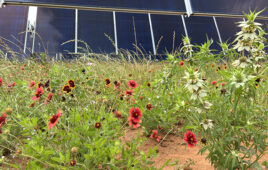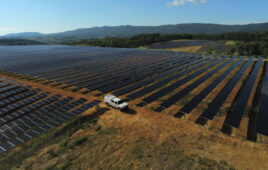By Bentham Paulos, principal of PaulosAnalysis
As solar power makes its way into the mainstream, it is finding a warm welcome in the faith community. Many churches, synagogues, mosques and other U.S. houses of worship now bear solar panels.
Solar delivers two big benefits to congregations. By costing less in the long run than buying power from the grid, it enables faith groups to direct more money to charitable uses, like helping refugees and the homeless. And by reducing the use of fossil fuels, it contributes to the obligation to steward the Earth’s resources for future generations and reduce the impacts of pollution on the most vulnerable.
“We understand creation care not to be ancillary to our ministry, not to be tangential to the work of proclaiming the gospel, but perfectly in the center of what it means to be a Christian,” said Kyle Meyaard-Schaap, national organizer for Young Evangelicals for Climate Action.
“Green teams” of congregants all over the country are working to bring solar to their own houses of worship, with support from advocates, investors and the U.S. Department of Energy Solar Energy Technologies Office.
There are four faith-related efforts among the 170 teams nationwide that have been selected to compete in DOE’s Solar In Your Community Challenge, a $5 million contest that supports “innovative and replicable community-based solar business models and programs that will bring solar to underserved communities.”
Faith in Place Solar
Faith in Place, a not-for-profit organization affiliated with Interfaith Power & Light, has promoted sustainability at houses of worship in Illinois since 1999, working with teams of volunteers on energy and climate change, sustainable food and land use, water preservation and advocacy.
So far, Faith In Place counts 14 houses of worship with solar in Illinois, including Quakers and Mennonites, as well as Jewish Reform, Catholic and Presbyterian denominations.
But with the passage of the Future Energy Jobs Act (FEJA) last year, the Rev. Booker Steven Vance sees a huge potential for growth. Pastor Vance is policy director for Faith In Place, and led its efforts on the legislation.
FEJA set new policies for distributed and community solar, job training programs and a low-income solar program called Illinois Solar For All.
“Our goal was to get low-income communities greater access to solar,” Vance said. That includes deployment in “environmental justice” communities, neighborhoods that bear the brunt of decades of pollution.
Faith in Place is working with Millennium Solar, the Little Village Environmental Justice Organization (LVEJO), the Safer Foundation and Blacks in Green (BIG) on a job training program that has provisions for foster care alumni and “returning citizens,” people who are returning to society after jail time.
They plan to work with Trajectory Energy, a Chicago-based solar company, to develop “church-top” and community solar projects, but the groups are waiting for final rules under FEJA to be promulgated by the Illinois Commerce Commission.
Fellowship Energy
While faith leaders and congregation members may be eager to reduce pollution, they can quickly encounter the financial complexities created by state and federal incentives for solar that are based on tax credits and accelerated depreciation.
This is where Fellowship Energy comes in. Launched in 2016, Fellowship is a solar finance company that specializes in working with faith communities to help solve the financial puzzle. Houses of worship, like other non-profit organizations, don’t pay income taxes, so they are not directly eligible for tax credits that apply to income.
Lenders also shy away from churches, said Phil Kwait, founder and CEO of Fellowship. “A property lien is off the table, because few investors want to take possession of a house of worship” if the loan fails, he said.
Solar Faithful
The City of Ann Arbor is working with the Michigan chapter of Interfaith Power & Light on the “Solar Faithful” project, urging local houses of worship to go solar and testing ways to finance it.
“Investing in renewables is a way for houses of worship to practice good earth stewardship and good financial stewardship,” said Bob Chapman, executive director of the Michigan IPL. IPL is a national network with chapters in 38 states, working with people from 18,000 congregations as a religious response to global warming. “Many would like to do solar, so we’re looking for that economically viable model that would enable them to take that step.”
The project has been talking to about a dozen congregations and has not found a single financial approach that will work for all.
“Houses of worship are unique in their financial needs, it’s not one-size-fits-all,” said Jane Vogel of IPL. “We are providing a range of options.”
For example, one congregation is building a new facility and may be able to roll solar into the project. Another has congregants that want to be the investors. A third is thinking of asking congregants to buy solar panels for the church as a donation.
“Investor models are complicated, and it’s still early days,” Vogel said. “We are still getting up the learning curve.”
Houses of worship represent a particularly large solar opportunity in Ann Arbor. There are over 150 within city limits, and they tend to have larger-than-average roof spaces compared to many nonprofit organizations. Vogel said they are hoping to get at least three projects built in Ann Arbor in 2018.
They then can take the lessons learned from this pilot project statewide and apply it to all types of nonprofit organizations interested in going solar.
Green the Church RED (Renewable Energy Development)
Green the Church, based in Oakland, California, is working with black churches across the country on sustainability, including solar power. For the DOE Solar Challenge, the Rev. Ambrose Carroll has been engaging and educating congregations on the potential for solar power “to get people ready for the technology.”
Rev. Carroll, founder of Green the Church, said environmental justice issues are a key attraction to church-goers. “Urban and rural congregations have had so much stress around pollution,” he said. “Fracking is the order of the day in Louisiana, where I’m from, changing the scope of our environment.”
But he also sees an opportunity for empowerment. “One larger factor for African-Americans is the opportunity to be part of industry,” he said. “For too long we have been consumers. Now we can be not just consumers but also producers.”
Still, arranging the finances to bring solar to low-income people is a struggle. “Like the children of Israel, low and moderate income people need to make bricks with no straw,” he said, citing the book of Exodus.
While Green the Church projects in New York and Maryland have run into policy and development delays, the group has had greater success working with RE-volv, a non-profit that uses crowd-funding to raise money for solar on community-serving non-profit organizations. When the funds are paid back, they are lent out to other projects, through a revolving loan fund. For the Faith Baptist Church in Oakland, RE-volv got support from 72 donors, including a funding match from the Leonardo DiCaprio Foundation.
Carroll sees tremendous potential among the 1,000 church congregations that Green the Church works with.
“There has never been a successful social movement without the African-American church at the table,” he said. “It’s time to wake the sleeping giant.”





Tell Us What You Think!